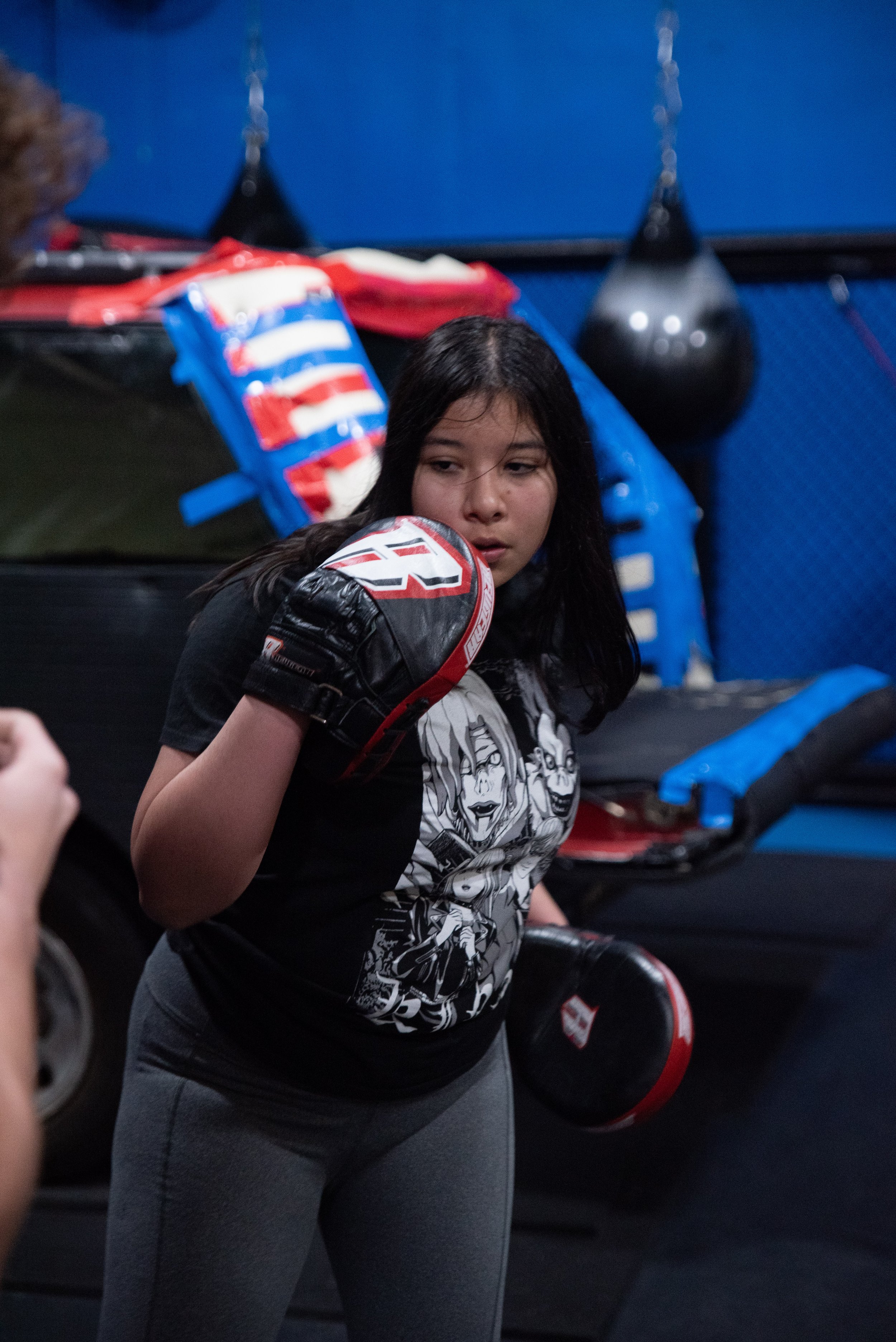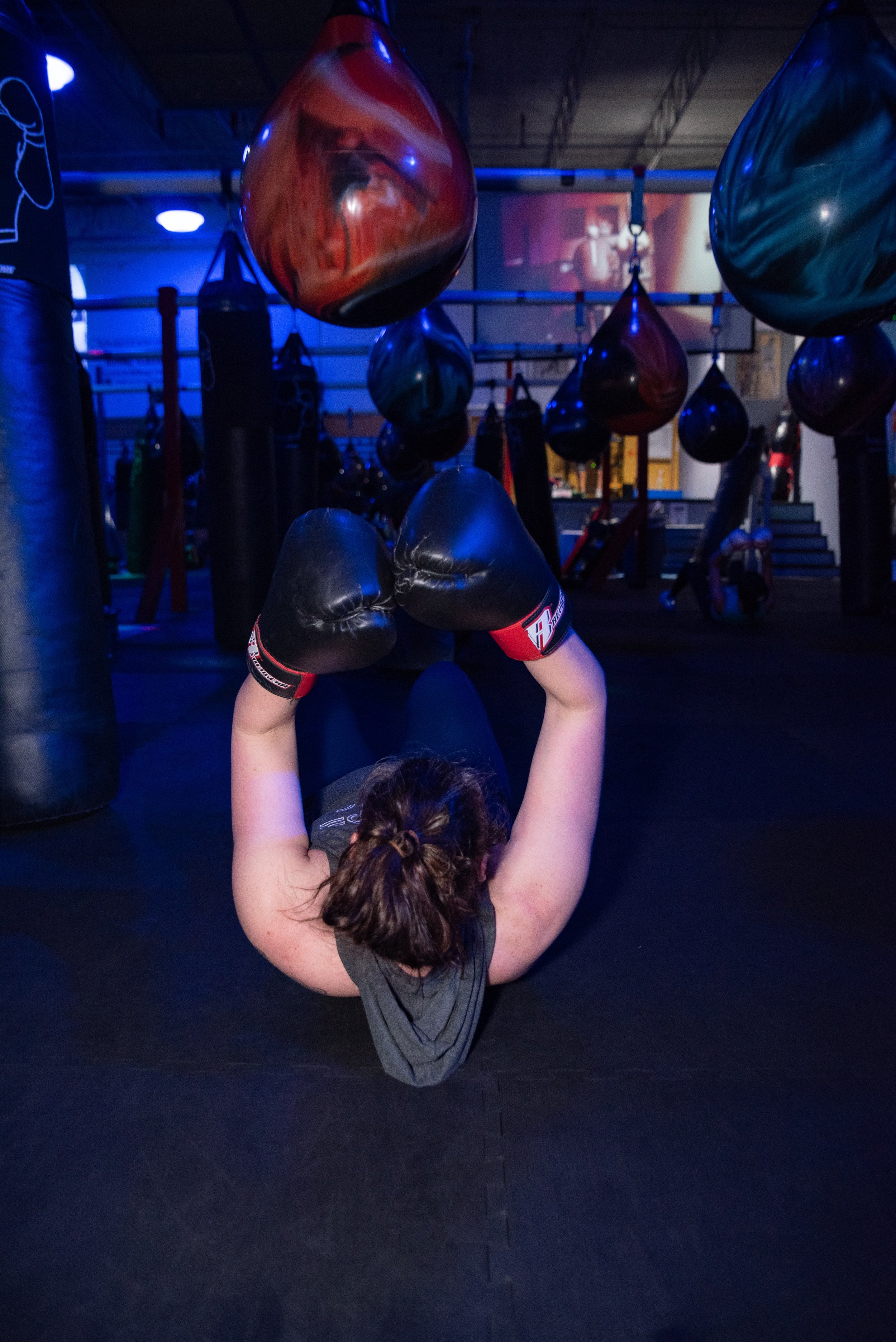Fight Back: The Krav Maga Advantage for Women’s Safety
By Iliana Yanez
Photography by Torry Sledge

A student trains with pads at STW Krav Maga
Let’s talk about self-care—of course, you’re probably envisioning reading a good book with some comfort food while watching your favorite TV show; but have you ever thought of adding self-defense to that routine? That’s right! While self-care embraces ways to nurture and restore your mental and physical health, self-defense practices aim to protect oneself. San Antonio is home to a business offering a path to empowerment and safety through its women-only Dangerously C.U.T.E programming (an acronym for “Courageous. Unwavering. Tenacious Empowered.”).
Under the guidance of Krav Maga fitness veteran Pete Hardy, STW Krav Maga is a sanctuary where fitness meets physical empowerment. It’s more than a place to sweat; it’s a haven where individuals, regardless of background or ability, discover their inner strength and resilience. Through Hardy’s unwavering commitment to fostering a sense of belonging and providing invaluable self-defense knowledge, STW Krav Maga stands as a beacon of transformation for bodies, minds, and lives within its welcoming walls.
Understanding Krav Maga
Krav Maga, translated as “contact combat” in Hebrew, is a practical and efficient self-defense system developed for real-life situations. Originating in Israel, it was initially designed by Imi Lichtenfeld, drawing from his experiences in boxing, wrestling, and street fighting. What sets Krav Maga apart is its emphasis on simplicity and effectiveness, making it accessible for people of all ages, genders, and fitness levels.
Krav Maga techniques are tailored to neutralize threats swiftly, focusing on instinctive movements and utilizing the body’s natural reactions. Unlike traditional martial arts, Krav Maga prioritizes practicality over formality, teaching individuals to defend against various attacks, including grabs, strikes, chokes, and weapon threats.
Central to Krav Maga’s philosophy is the principle of simultaneous defense and attack. It incorporates elements of striking, grappling, and defenses against armed assailants, aiming to render threats ineffective—quickly and decisively. Additionally, Krav Maga places significant emphasis on mental preparedness, situational awareness, and the ability to de-escalate conflicts whenever possible.
Krav Maga’s versatility lies in its adaptability to real-world scenarios, preparing individuals to react effectively to unexpected and high-stress situations. Its primary goal is to enable practitioners to defend themselves and others while minimizing injury, making it a valuable self-defense system for everyday life.
Why Self-Defense Matters for Women Today
Unfortunately, women often encounter situations where safety is compromised, ranging from verbal harassment to physical assaults. It’s in these moments that the ability to protect oneself becomes crucial. These classes do more than teach skills; they also reinforce the ideology that women are capable of protecting themselves.
Krav Maga stands as more than a practical self-defense system—it holds special importance for women seeking vital self-protection skills. By focusing on women, Krav Maga’s training not only arms women with the ability to fend off attacks, but also fosters a newfound confidence and preparedness. This transformative journey enables women to proactively safeguard themselves, and confidently navigate life’s challenges with strength and assurance.

Class in session at STW Krav Maga
All Women are Dangerously C.U.T.E: Exploring Krav Maga
In addition to its other programming, STW Krav Maga has a program solely for teaching and supporting women during violent situations. Dangerously C.U.T.E. seminars do more than teach self-defense – they aim to make women and kids their own protectors in any situation. The focus is on building bravery, self-expression, and confidence in every part of life.
They travel all over the country to ensure women learn vital self-defense techniques crafted to shield them against various dangers like assault, kidnapping, and other potential threats. In addition, they stress the significance of situational awareness as a means of enhancing personal safety. Recognizing the emotional toll following such events, they prioritize mental health support, assisting individuals in navigating the aftermath and working through resultant trauma.
Moreover, they’re deeply engaged in the community, actively advocating for a culture of support and empowerment among women. Their commitment extends beyond the classroom as well, ensuring women feel equipped to handle life’s challenges.
Scene in SA explored how Krav Maga is important, especially for women. Pete Hardy’s experience led him to discover how self-defense engenders safety.

Effective training takes on various forms
What inspired the creation of Dangerously C.U.T.E?
“My two daughters [Jen and Paige]. I noticed over the years there were instinctive things that women do and don’t do that were not in the Krav Maga system on how people react. The Krav Maga system is built on instinctive reactions. But as I trained women and held women-only seminars, what we thought was instinctive for a female was not. So, I started changing the program and techniques to fit what I saw happening when we would train women. I realized I needed to tweak the system to really accommodate how women react when they’re being choked, or when they’re in a bear hug, or when a man’s on top of them. So, we rebuilt the whole program, and my two daughters came up with the name Dangerously C.U.T.E. [They] were my motivation to create a program specifically to address the kind of attacks that happen to women. We do a lot of work with law enforcement, the rape crisis center, women’s shelters, so [they provide details] on how real attacks happen [in houses, cars, or in the streets] and then we would mimic that and continue to develop the program around the most common attacks to women of all ages.”
How does your program differentiate itself from other women’s self-defense programs?
“We take your natural instincts and reinvent them into self-defense. We are a true defensive tactic self-defense survival system. We don’t do anything for sport, we don’t issue belts, we don’t go to tournaments because that’s not who we are. We spend all of our time teaching people, from day one, techniques that will save their lives in life-threatening situations, and that’s all we teach. We train women and men how to stand up and fight. We train them how to be on the ground and fight... The common mistake that people make is that all of a sudden, self-defense becomes a thing. The difference in our training is, when people come in here, a lot of them are survivors. When they leave, they leave with a level of confidence they never had, with a feeling of accomplishment and security they’ve never had, and they always walk out of here learning a skill.”
Apart from physical self-defense, you mentioned addressing mental health and trauma. How does your program integrate mental preparedness and support for individuals dealing with trauma post-conflict?
“We call it the winning mindset. Over the years of training, I’ll be very honest with you; for years and years, [women would], instead of fighting, close their eyes, and start holding on to the attacker—not even verbalizing anything. When we do this, the instructor, who’s [acting as] the attacker, with two safety people always, but we’re in the ear of the student going ‘open your eyes.’ Finally, I figured out after having a lot of conversations with women who are survivors, they think ‘Oh, this isn’t happening again’—that’s what’s going through their mind. We started changing the conversation. Open your eyes! You can and will fight back! When seeing how people react to simulated attacks, you try to make it as real as you can, and then start building a program that truly accommodates what men, women, or young kids need to learn how to defend themselves.”
“We spend all of our time teaching people, from day one, techniques that will save their lives in life-threatening situations, and that’s all we teach. We train women and men how to stand up and fight. We train them how to be on the ground and fight.”

Students learn to defend against a range of threats in the Dangerously C.U.T.E seminars
How do you tailor your training sessions to address various types of threats, such as sexual assault, human trafficking, home invasion, and carjacking? Are there specific techniques or approaches for each?
“Instead of just making [scenarios] up, we have access to reading case histories. We started developing the program in my facility that has a house, a car, a fuselage, and all that; we get in the real space. We mimic that, and [work out] what could have been done and should have been done to survive that situation. Each situation has a unique set of circumstances on what to do and what not to do.”
How do you keep your training techniques and curriculum updated to align with evolving threats or changing circumstances in society?
“One Saturday, every month, all the instructors have to be here, and for 4 hours, we train hard in realistic situations... As we hear or see things change, then we start playing with better ways to improve that technique. Can we make it better or has the bad guy learned our way of doing things? [We have] the privilege of working with a lot of law enforcement and military so that we hear all the things that are going on. When you see the Krav Maga logo, it’s called a Koopman; it’s a ‘K’ and an ‘M’ in Hebrew, and you’ll see it’s open at both ends. That’s information in, information out. We are constantly evolving and changing our system to accommodate exactly what you said: as crime changes, we change.”
What impact or changes do you hope to bring about in the San Antonio community through your program?
"We’ve been here for 21 years and had a huge impact on changing people’s lives. That’s all we do here. I’ve been in the fitness industry for 50 years; my entire adult life, and I worked for the largest fitness companies in the United States. I have a previous fighting background and I’ve been in Krav Maga for 25 years. When I started this concept, we did Krav Maga first, and then I built our fitness program to accommodate the Krav Maga program. The way I looked at it with my background is that the best athletes have the best condition: they’re lean, fast, and process information quickly. I think that’s what most people want to look like and feel [like], not ripped and cut. They want the ability to move when you need to move and hit hard when you need to hit hard, but also to have the ability to take a beating if necessary. All 15 class styles that we teach here in our fitness are to support the program, and to make you a better mother, a better father, a better sister, a better brother, a better anything based on the self-confidence that you would have in the ability to protect yourself and your family.” ■
This interview has been edited for conciseness and clarity.

